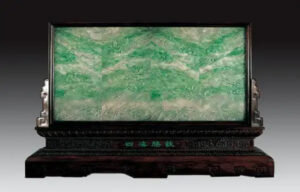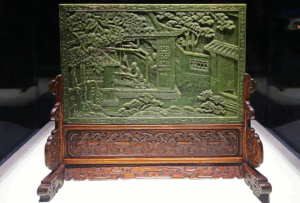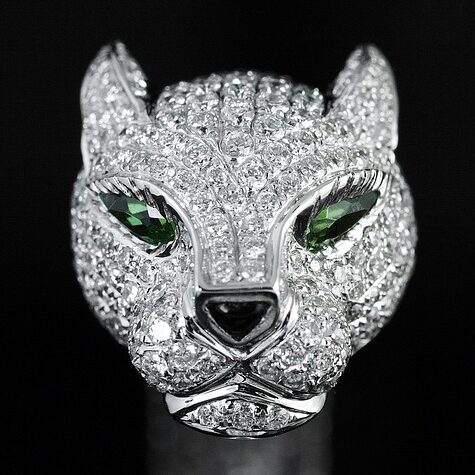Cloisonné Through the Ages: A Comprehensive Analysis
博覽古今:歷代景泰藍解析
Cloisonné enamel, commonly known as “Jingtailan” in Chinese, represents one of China’s most splendid traditional crafts. This intricate technique involves creating designs with thin metal wires (typically copper or gold) soldered onto a metal base (usually red copper, occasionally gold), filling the compartments with colored enamel pigments, then firing, gilding, and polishing to create magnificent pieces where brilliant enamels interplay with intricate gold patterns, exuding royal splendor.
金屬胎掐絲琺瑯器俗稱「景泰藍」,其製作工藝以金屬(主要是紅銅,少量為金)做胎,用細而薄的金屬絲焊著於成形的金屬胎表面形成花紋,然後填施各色琺瑯料,再經焙燒、鍍金及磨光等工序,成品厚重華美,琺瑯五彩斑斕,與通體繁密的金線和金飾交相輝映,呈現出富貴豪華之氣派。
Born within imperial palaces, cloisonné formed an essential component of royal heritage, serving as main hall displays and treasure pieces. From the Forbidden City’s Hall of Supreme Harmony to the Imperial College’s Biyong Palace and Summer Palace’s Cloud Dispelling Hall, cloisonné’s gem-like brilliance in these imperial spaces never fails to astonish.
景泰藍誕生於皇宮,是皇家重要的組成部分,是皇宮大殿的主要陳設,亦是鎮殿之寶。紫禁城金鑾寶殿,或者是國子監辟雍宮、頤和園排雲殿等等,在這些帝王尊屬的殿堂,景泰藍的寶石般的光芒總是令人讚嘆。
The Palace Museum houses over 4,000 cloisonné pieces spanning Yuan through Ming to late Qing and Republic periods, comprehensively showcasing Chinese enamel art’s development. We’ve selected the most representative works from each dynasty to introduce this treasure of traditional craftsmanship.
故宮博物院現藏金屬胎掐絲琺瑯器四千餘件,自元明以迄晚清民國,各個時期的琺瑯作品大備於此。我們在眾多藏品中百里挑一,選擇了歷朝最具代表性的作品,以引領朋友們認識和欣賞我國傳統工藝中的這一瑰寶。
I. Late Yuan-Early Ming (14th-15th Century)
一、元末明初
Late Yuan-early Ming cloisonné features fine, clean enamel with crystal-like transparency. Red, blue, purple, and grass-green enamels appear particularly vibrant. Patterns predominantly show lotus scrolls with large blooms, thick spreading leaves, and spacious layouts interspersed with small buds.
元末明初的掐絲琺瑯器釉質細膩潔淨,表面晶瑩若水晶,紅、藍、紫、草綠等色琺瑯鮮豔醒目。此時期圖案多為纏枝蓮花紋,花朵碩大,枝葉肥厚舒展,佈局疏朗大方。
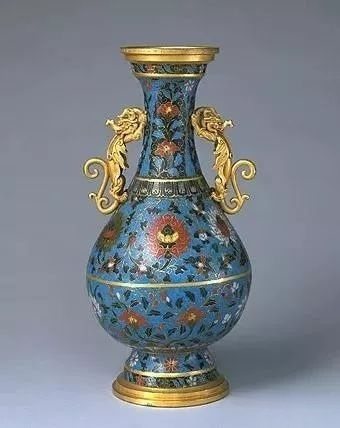
掐絲琺瑯纏枝蓮紋龍耳瓶
II. Ming Xuande Reign (1426-1435)
二、明宣德
The earliest dated cloisonné pieces bear Xuande marks. Xuande enamels display pure, rich, subdued colors with warm surface luster, though losing Yuan’s crystal transparency. Lotus scrolls remain primary decoration, continuing Yuan’s single-line vine outlines with large, full petals.
目前所見掐絲琺瑯實物中時代款識最早者即為宣德款製品。宣德時期的掐絲琺瑯器琺瑯色澤純正、濃郁、沉著,表面光澤溫潤。纏枝蓮花紋仍然為主要的裝飾題材,且沿襲元代風格,以單線勾勒枝蔓,花葉碩大飽滿。
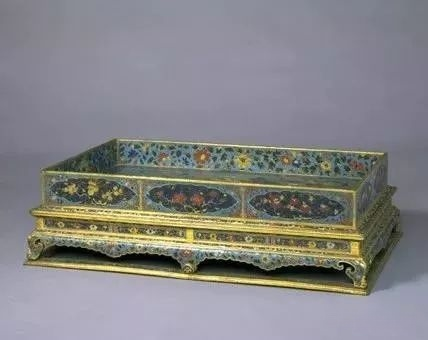
掐絲琺瑯獅紋雙陸棋盤
III. Mid-Ming (Mid-15th-Early 16th Century)
三、明中期
Mid-Ming cloisonné introduced changes in floral patterns and enamel quality. Beyond lotus scrolls, sea horse, lion playing with ball, and flower-bird patterns gained popularity. Wires became more delicate, patterns denser. Most pieces show low gloss and increased pitting, reflecting declining enamel quality.
明代中期的銅胎掐絲琺瑯器在花葉紋飾和琺瑯質地上都產生了一些新變化。纏枝蓮紋之外,海馬紋、獅戲球紋、花鳥紋等也頗為流行。掐絲線條愈加纖細,圖案佈局亦顯繁密。作品大多表面光澤度低,砂眼增加,反映出琺瑯質量的下降。
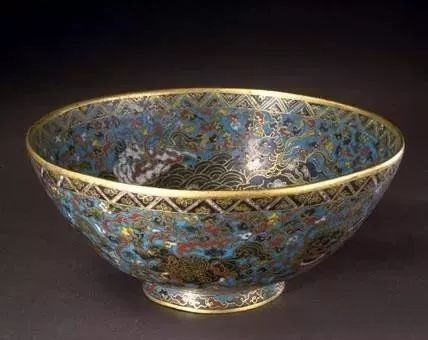
掐絲琺瑯獅戲球海馬紋碗
IV. Late Ming (16th Century Onward)
四、明晚期
After mid-16th century, Chinese cloisonné underwent unprecedented changes, particularly during Wanli reign (1573-1619). Changes included “biomorphic” shaped vessels, expanded enamel color variety, popular auspicious and religious themes, and prevalent double-line outlining technique.
16世紀中期以後,我國的掐絲琺瑯器產生了前所未有的變化。這種變化主要表現在 「仿生」造型掐絲琺瑯器的製造;琺瑯顏色品種的增加和運用;各種吉祥圖案和宗教題材的流行。此外,這一時期更盛行雙線勾勒技法。
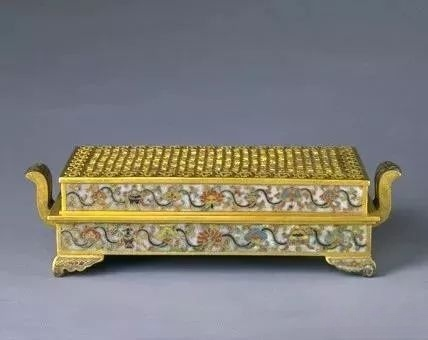
掐絲琺瑯八寶紋長方熏爐
V. Early Qing (Kangxi Reign)
五、清早期
Kangxi cloisonné represents early Qing development—a transitional period. Early pieces followed Ming models from palace workshops. Through practice and accumulation, works achieved pure enamel colors, smooth surfaces, and fine regular wires, directly influencing later development. After 1681, with establishment of enamel workshops, imperial cloisonné began large-scale standardized production.
清康熙朝的琺瑯器可以代表清早期掐絲琺瑯工藝的發展狀況。康熙初期主要以遺存於宮內的明代御用監製造的掐絲琺瑯器為樣板,所成器物的琺瑯色彩純正、表面光潔、掐絲細而規整,直接影響著後世琺瑯工藝的發展。康熙十九年以後,隨著琺瑯作的設置,御用掐絲琺瑯器開始了大規模和規範化的生產。
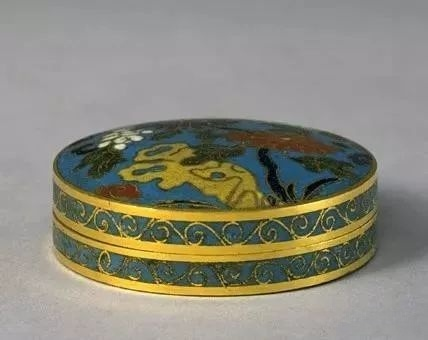
掐絲琺瑯菊石紋小圓盒
VI. High Qing (Qianlong Reign)
六、清乾隆
Emperor Qianlong particularly favored metal enamelware, actively supporting its production and achieving unprecedented accomplishments. Main production centers were Beijing and Guangzhou. Qianlong period produced numerous cloisonné pieces with constant innovation in forms and extensive uses in palace ceremonies and daily life. Technical excellence reached its peak with regular shapes, thick bodies, and bright gilding—reflecting the prosperous nation’s substantial resources.
乾隆皇帝對金屬胎琺瑯器可謂偏愛有加,積極支持並推動中國金屬胎琺瑯器的製作工藝,取得了空前的成就。乾隆時期的掐絲琺瑯器數量繁多,形制不斷翻新,用途也十分廣泛。這一時期的琺瑯製作工藝精益求精,成型規整,胎壁厚重,鍍金光亮,顯示了清盛世殷實的國力。
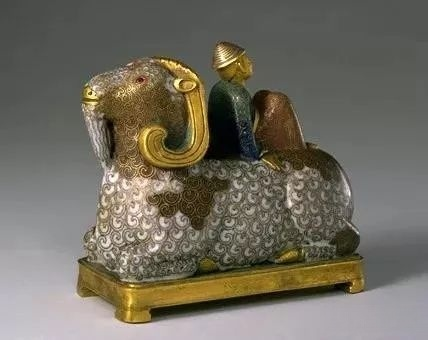
掐絲琺瑯牧羊人筆架
VII. Late Qing & Republic Period
七、清末及民國
After 1840, metal cloisonné production declined. However, during late Qing and Republic periods, cloisonné became profitable export merchandise, stimulating commercial workshops outside court, such as “Lao Tianli” and “Zhiyuan Tang.” Pieces from this period feature even wire thickness, smooth polishing, glossy surfaces, and popular enamel colors including blue, red, white, yellow, black, and green.
道光十九年以後,金屬胎掐絲琺瑯器的生產每況愈下。然而至清末及民國時期,由於掐絲琺瑯器成為一種可獲利潤的出口商品,因而刺激了宮廷之外商營作坊的生產。這一時期的掐絲琺瑯器線條粗細均勻,打磨平整,表面光亮潤滑,盛行以藍、紅、白、黃、黑、綠等幾種顏色的琺瑯作裝飾。
Read More
- Collectors' Academy (144)
- Care Academy (7)
- Investment Academy (22)
- Jade Crafting Techniques (28)
- Michelle Au: The Gemstone Luminary (11)

